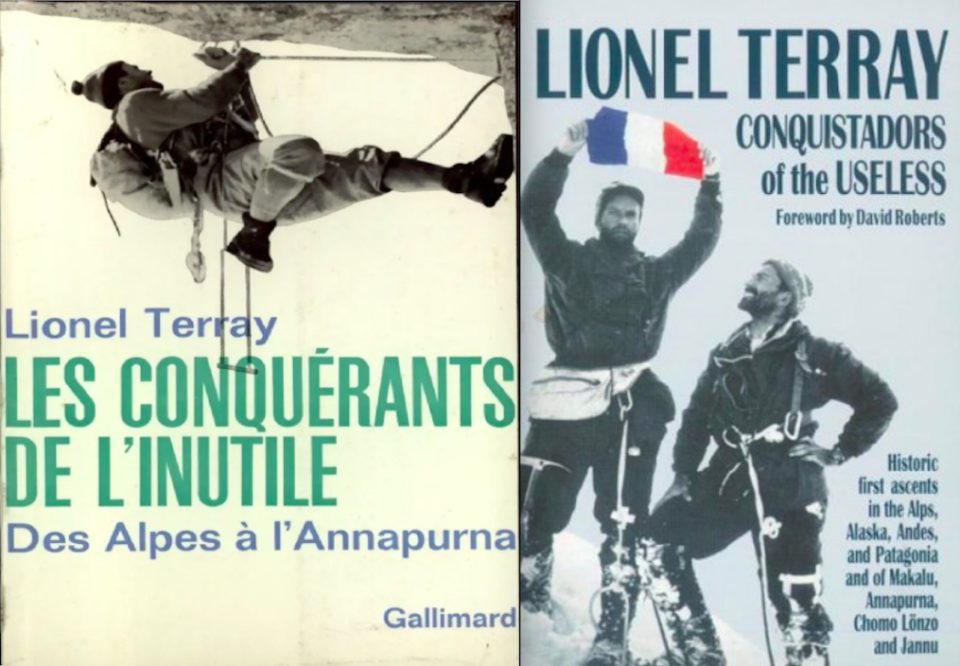In 1940, when he was 19, Lionel Terray left school to become a farmer and mountain guide. He came from a well-to-do family that had high hopes for him, but Terray had simpler ambitions – to live simply in the mountains, with plenty of time to climb. By his own admission Terray was never more than a mediocre farmer, but he developed into a superb climber, known for his speed and prodigious strength. In the years immediately after the Second World War, he set speed records on many of the routes around Chamonix, often roped with his great friend and collaborator Louis Lachenal.
Together they made an electrifying ascent of the Walker Spur of the Grandes Jorasses, then the north spur of Les Droites, the north-east face of the Piz Badile, and many more. Their masterpiece was the second ascent of the Eiger’s North Face, which they climbed in three days in 1947, topping out in a blizzard and descending in a lightning storm. Three years later both men took part in the French first ascent of Annapurna, the first 8,000-meter mountain ever climbed and the only such first accomplished without supplemental oxygen.
Lachenal reached the summit with expedition leader Maurice Herzog, at the cost of ten toes. Terray was instrumental in their escape, a two-day ordeal through yet another storm. After the first night, Lachenal’s frozen feet were too swollen to go back in his boots, so Terray gave up his own and squeezed into his friend’s smaller pair. They spent the second night in a crevasse that Lachenal had fortuitously fallen into as they searched vainly for their advance camp, and were awakened by an avalanche sweeping over the crack. When they dug themselves out from a covering of light snow, the sky above them was clear blue and the missing camp only a few hundred yards away. Back home in France they were received as heroes.
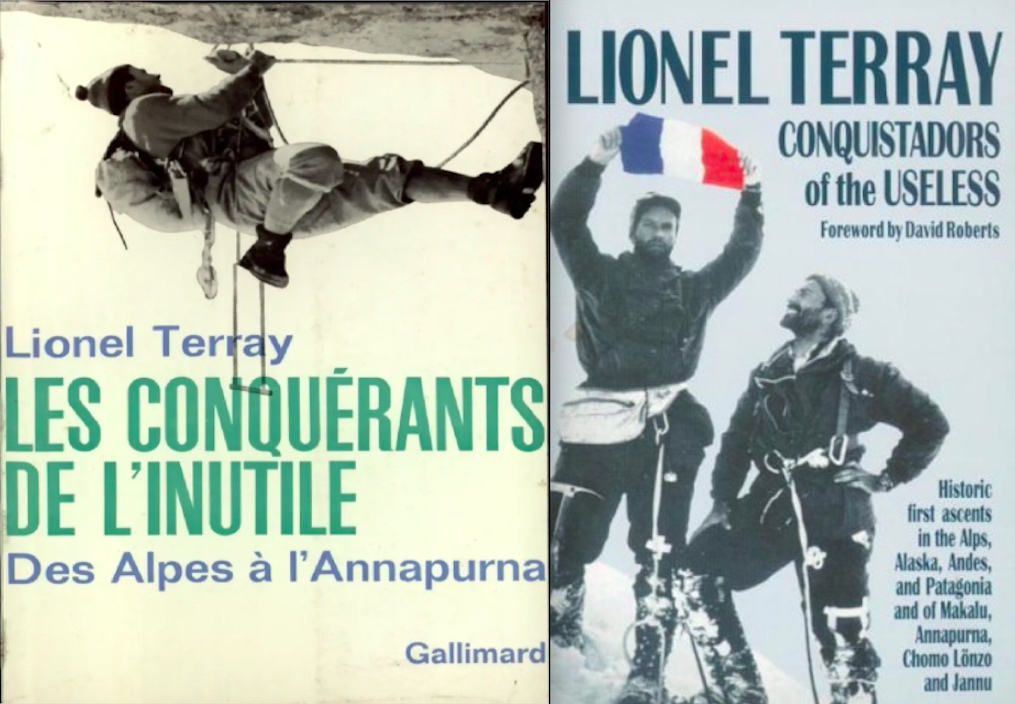 Terray’s autobiography, Conquistadors of the Useless has been called the finest mountaineering narrative ever written.
Terray’s autobiography, Conquistadors of the Useless has been called the finest mountaineering narrative ever written.
Terray would later take a leading role in four more major ascents in the Himalaya and five in the Andes. As a climbing guide based in Chamonix he took part in some of the most notable mountain rescues of the post-war era, and introduced thousands of men and women to the world of beauty and adventure in which he lived. Along the way he found time to make the first ski descent of Mont Blanc and pen his autobiography, Les Conquérants de l’inutile, which none other than David Roberts called the finest mountaineering narrative ever written. The title alone, rendered as Conquistadors of the Useless in Geoffrey Sutton’s excellent translation, is as expansive a description of climbing’s peculiar draw as any four words can be. Even Mallory’s famously terse “because it is there” required several paragraphs of patient unpacking, but Terray’s words leave the nuance to the reader’s imagination.
Terray’s conquests include a handful of superlatives, among them the 1955 first ascent of Makalu, at 27,766 feet the world’s fifth-highest mountain, but he was most drawn to a particular kind of useless — virgin peaks combining great aesthetic beauty and mountaineering challenge. Among these were his first ascents of Cerro Fitzroy in Patagonia and Peru’s so-called impossible mountain, Nevado Chacraraju. “My dream was to tackle mountains which would give harder and more complex problems than the Alps, but remain within the scope of a normal rope of two men,” he wrote.
Lionel Terray was born in 1921 in Grenoble to a family he described as “intellectual bourgeoisie.” Terray himself was an indifferent student, and after his parents split in his teens he contrived to get expelled from one boarding school, and ran away from another to compete in a series of ski races. With no prospects of an intellectual career and no trade to fall back on, by early 1940 he was ready to join the French Army. Before he could enlist, however, the German Blitzkreig swept through France in a mere six weeks. Terray took refuge in the newly formed mountain youth corps, Jeunesse et Montagne, and then rented a small farm to try his hand as, in his words, a peasant. The profession had the benefit of ample food through the lean war years, time enough to ski in the winter, and exemption from forced labor in Germany.
Terray managed to live peacefully through the early years of the war, but by late 1944 he had joined the resistance, harrying German forces along the high Alpine ridges on the Italian frontier. This work, at least in the beginning, was more about climbing than fighting. On one occasion Terray and his squad carried a machine gun to a point far above and nearly half a mile away from a German position. The weapon was nearly useless at that range, which suited Terray just fine. “Men ran in every direction in the snow, but no one seemed to be hurt. After a few minutes of this cruel game we grew weary of shooting at men who were unable to defend themselves and withdrew, satisfied at having carried out our mission.
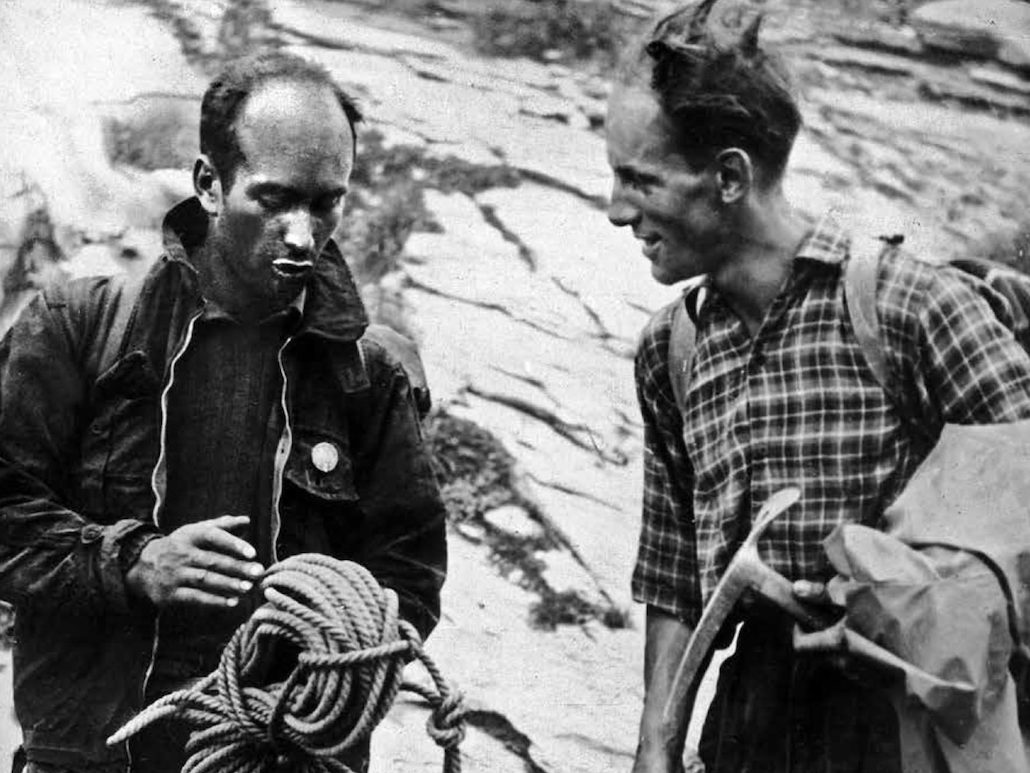
Terray, left, and Lachenal formed one of the great partnerships of the era. “We were very much better together than either of us were apart,” Terray said.
“What we enjoyed in this pointless and obsolete form of war was its resemblance to mountaineering,” he wrote. But months later, with the German defeat already a foregone conclusion, Terray took part in a violent clash in which both sides suffered heavy losses. The experience affected him deeply. Descending through an Alpine valley after the fight, he wrote “the whole abomination of war was suddenly and overwhelmingly apparent to me.”
Later that spring he met Louis Lachenal in a train station, and, as the least destitute of the pair, bought him a beer. Soon they were climbing together whenever their guiding commitments allowed. Their skills and temperaments were complimentary, but both shared the gift of speed. In those days no one in Chamonix climbed faster than Terray unless it was Lachenal. And together they climbed faster still.
Their first really noteworthy climb was the fourth ascent of the Walker Spur on the Grandes Jorasses, an Alpine face second only to the Nordwand itself in complexity and commitment. One of the route’s chief obstacles was its sheer length. No one had completed the climb in less than three days, and to complicate matters Terray and Lachenal were working full time as guides. They didn’t have the luxury of waiting for a weather window. They had one long weekend to pull it off.
Their solution was to go light. After jettisoning all but the most essential gear, they reduced their three-day pack to 25 pounds. Still too heavy. The obvious conclusion was to climb the route in two days, with a sack of 20 pounds that left no margin for error or delay. At their first bivouac the clouds broke open and it hailed through the night. In the morning the face was covered in an inch-thick mantle of black ice. Fortunately, their lightweight kit included one pair of crampons between the two of them. Terray led as Lachenal followed in boots he had made himself, soled with rubber cut from old tires.
They topped out late the same evening and descended like new men, full of confidence and the joy of a hard-won goal. Two summers on, in 1947, they climbed the infamous North Face of the Eiger in three days. Their work together earned them an invitation to join the French national expedition to the Himalaya in the spring of 1950. The campaign bore little resemblance to a modern expedition. To start with, they had no clear idea of which mountain they would climb. Their first choice was Dhaulagiri, on the strength of its height, some 250 feet higher than neighboring Annapurna.
They had no good maps, and needed more than a month to march to the environs of Dhaulagiri, assess its many difficulties, and then find their way to Annapurna. During this long approach, and as the team ferried supplies to camps on the mountain’s avalanche-prone north face, Terray showed himself to be in exceptional form. According to Roberts, the expedition Sherpa’s dubbed him “the strong sahib,” but Terray himself tells it differently. Impressed with local porters’ use of a tumpline to carry heavy loads, he tried and failed to master the art. “My troubles were so obvious that the porters, with typical humor, nicknamed me ‘the French Sherpa,’ a title always accompanied with roars of ironic laughter.”
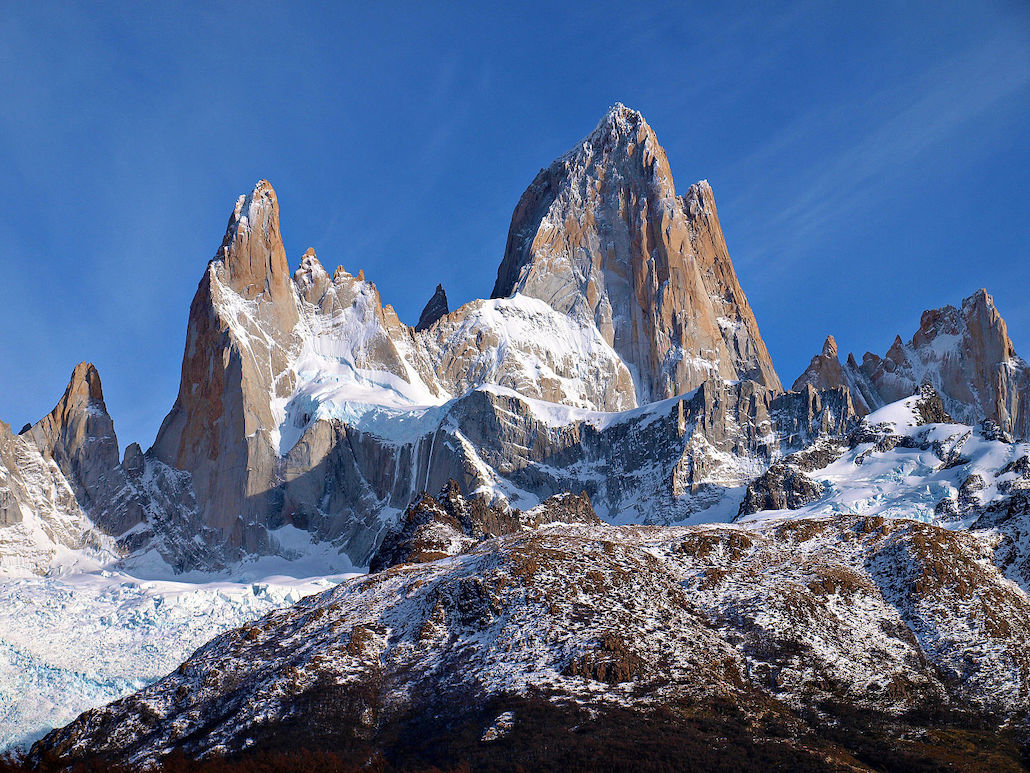
Terray was drawn to difficult and beautiful mountains. He made the first ascent of Cerro Fitzroy in 1952. Wikimedia Commons/Todor Bozhinov
Terray was tapped as a likely summit companion to Herzog, but effectively gave up the spot when other team members were unable to keep their assigned schedules. Rather than going down to rest for a summit push, which would cost the team a day and reduce its chances of success, Terray elected to carry needed supplies to Camp Four. The effort left him unfit for the final push, and it was Lachenal who accompanied Herzog to the historic summit.
When Herzog returned to the high camp with news of victory, he told Terray that Lachenal was right behind him. But Lachenal, his feet frozen stiff to the ankles, slipped off the face and slid past the camp. Terray heard a distant shout, and, thrusting his head from the tent, saw his friend some 300 feet below. Without pausing to put on his crampons, he glissaded to the spot where Lachenal sat, hatless, glove-less, axe-less and with only one crampon. So desperate was Lachenal to get down that Terray had to cajole him back to the tent, where he cut off his frozen boots and massaged his feet through the night.
The next morning Terray traded boots with Lachenal, stripping off his extra socks to fit into Lachenal’s boots, two sizes smaller than his own. Some 18 hours later, lost in a gale and almost out of hope, Lachenal fell into a crevasse. It was a lucky accident. No more than 12 feet deep, the snow cave offered protection from the wind, and three men – Herzog, Lachenal and Terray – squeezed their legs into a single sleeping bag. The fourth, Gaston Rébuffat, huddled close. The next morning’s avalanche, which in ordinary circumstances would have been deadly, passed overhead. “We were not buried so much as lightly covered,” Terray wrote of what was merely the latest in a long list of close calls.
Terray would return four times to the Himalaya, but only once more to an 8,000-meter peak. “Annapurna had given me the excitement of travelling in new lands, the joy of exploration, and almost too much of a good thing when it came to sheer adventure, but the actual climbing had been a disappointment,” he wrote. “Tough and thrilling as it was, Himalayan mountaineering, on this mountain at least, seemed something different in kind from ‘alpinism’, which I think of as an essentially individual experience, almost like artistic creation.”
Cerro Fitzroy, an absurdly beautiful granite spire in the Patagonian Andes, checked all the boxes. Terray led the first ascent in 1952, and returned to South America for an even greater challenge in 1956. Nevado Chacraraju seemed an impenetrable fortress, a 20,046-foot Peruvian giant guarded by columns of ice rising more than two and a half thousand feet. It presented a challenge beyond anything in the Alps and very little else in the world—like three Fitzroys stacked atop each other in Terray’s estimation. It’s reputation only added to his desire. A handful of German and American teams had been to have a look and deemed it impossible. One would-be expedition leader said Chacraraju would require siege or suicide, or probably both.
Terray led a team of six to the top in Himalayan style, methodically establishing a series of camps before climbing the last near-vertical pitches—2,500 feet up and back down—in a single 26-hour dash. The climb, perhaps the most spectacular in a career full of spectacular ascents, was followed by an episode that haunted Terray for the rest of his life.
In December 1956, two young alpinists became trapped high on Mont Blanc. Members of the Chamonix association of professional guides had warned them not to attempt the climb, and saw no reason to risk their own lives to bring the boys down. The lone exception was Terray, who organized a small team of amateurs to attempt a rescue. For this he was formally expelled from the association.
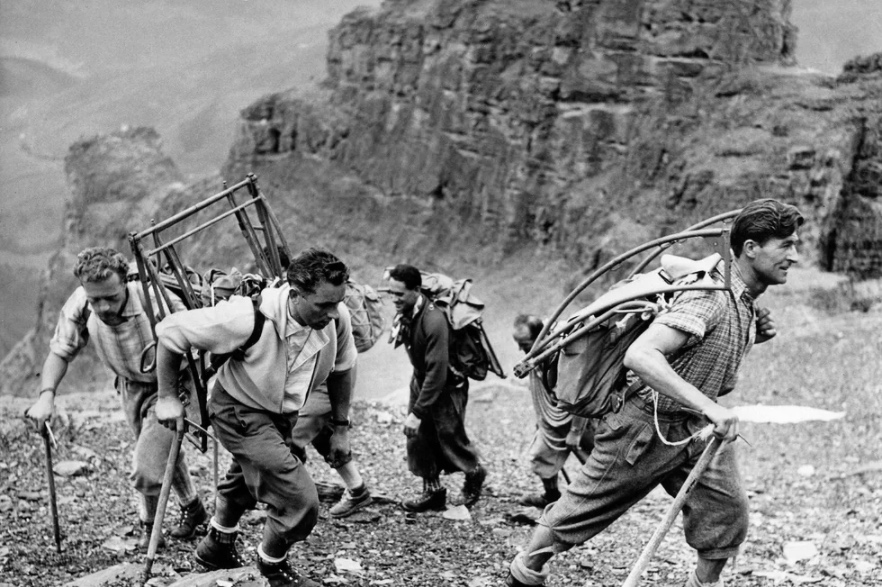
Climbers rushing to the summit of the Eiger to assemble the rescue apparatus in 1957. Courtesy Swissinfo.ch
Of all the angst that came from his war service, there was one bright spot. During the war he had regularly climbed and skied in conditions that would have been unthinkable during peacetime, and this gave Terray, in his own mind at least, ironclad confidence in his ability to assess snow conditions. Fellow guides thought the avalanche risk too high to justify a rescue attempt. Terray insisted the snow was good but could not muster enough climbers to bring the young men down from 12,000 feet. On the ninth day of their ordeal, a helicopter sent to rescue the young men crashed, and while no one was killed it was all the remaining rescuers could do to carry the wounded copilot to a refuge. The boys were given brandy and food, and told to wait for more rescuers, who never came.
The experience left Terray so bitter he could only wrote obliquely of it in his autobiography. The next year he played a leading role in another high-profile mountain rescue, this time on the Eiger Nordwand. Two pairs of climbers, one Italian and the other German, attempted the route, and to anyone watching from the valley it was obvious they were out of their depth. The four men moved excruciatingly slowly, for some reason climbing higher as storm clouds boiled on the horizon. That was a Tuesday, and they weren’t spotted again until the clouds cleared on Thursday. Again the local guides refused to lift a finger, on the grounds that anyone who attempts the Nordwand is off his rocker. Still, more than 50 climbers from all over Europe mounted an elaborate rescue, rigging a cable system on the summit (accessed by the western ridge) and sending a man down to retrieve one of the Italians, Claudio Corti.
Terray then took the bosun’s seat to retrieve Stefano Longhi, who was even lower on the mountain. He got close enough to hear the stranded man’s cries for help, but the weather began to close in and the rescuers on top reeled Terray up without the Italian. The two German climbers were nowhere to be seen; it was later learned that they had gone over the summit in the nasty weather and were killed in an avalanche on the other side.
The massive rescue effort, subject of the 1961 bestseller The Climb Up To Hell, had managed to save just one of the four men, but the effort was a salve for Terray after the debacle on Mont Blanc. It’s worth noting that the rescuers came not only from Switzerland, but also from Germany and Poland, France, Italy and other parts of Europe—men who only a dozen years before had been shooting at one another from one Alpine ridge to the next.
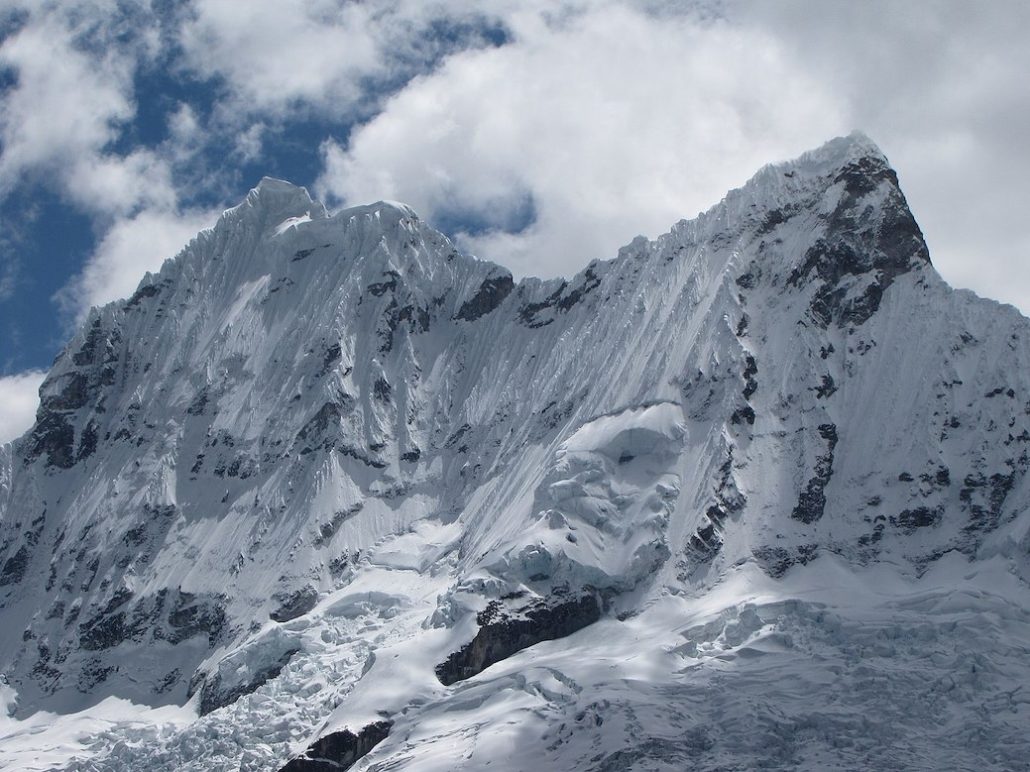
Chacraraju was deemed unclimable when Terray made the first ascent in 1955. Wikimedia Commons.
“The fact remained that mountaineers of many nations had combined together in a wave of spontaneous human feeling to save the life of a particularly foolish colleague, in spite of hopeless-looking conditions,” Terray wrote. “It had been a wonderful example of what can be accomplished by courage, enthusiasm and willpower, and if only for this reason it was a great achievement.”
Terray was 41 when Les Conquérants was published in 1962, and he admitted to questioning his motivation as a mountaineer: “Today my willpower is no longer quite so inflexible, the limits if my courage not so far out,” he wrote. His imagination, however, remained undimmed. He continued to notch climbs big and small, notably 25,295-foot Jannu in Nepal and the first ascent of Mt. Huntington, yet another ravishing and dangerous muse in the Alaska Range.
On September 16th, 1965, Terray and his climbing partner Marc Martinetti were found dead at the base of a beautiful limestone wall overlooking Grenoble, victims of an apparent fall.

